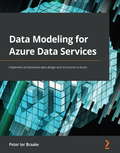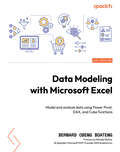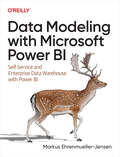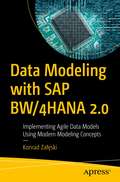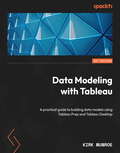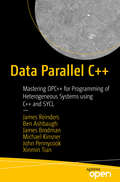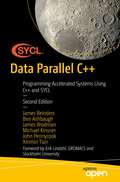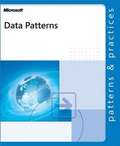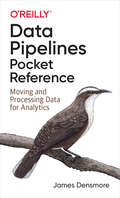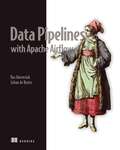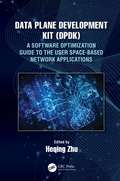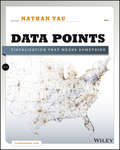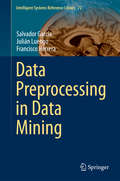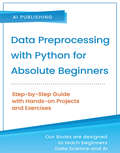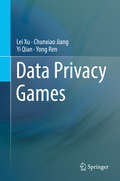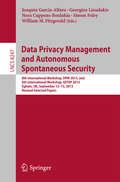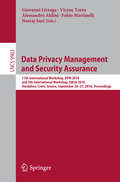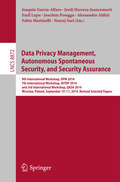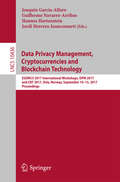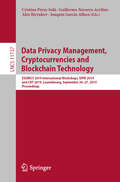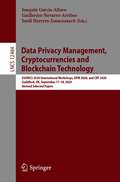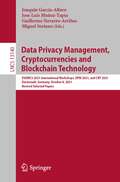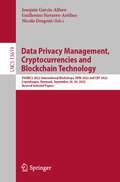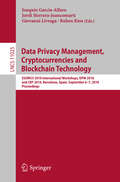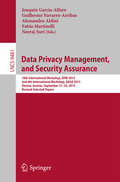- Table View
- List View
Data Modeling for Azure Data Services: Implement professional data design and structures in Azure
by Peter ter BraakeChoose the right Azure data service and correct model design for successful implementation of your data model with the help of this hands-on guideKey FeaturesDesign a cost-effective, performant, and scalable database in AzureChoose and implement the most suitable design for a databaseDiscover how your database can scale with growing data volumes, concurrent users, and query complexityBook DescriptionData is at the heart of all applications and forms the foundation of modern data-driven businesses. With the multitude of data-related use cases and the availability of different data services, choosing the right service and implementing the right design becomes paramount to successful implementation. Data Modeling for Azure Data Services starts with an introduction to databases, entity analysis, and normalizing data. The book then shows you how to design a NoSQL database for optimal performance and scalability and covers how to provision and implement Azure SQL DB, Azure Cosmos DB, and Azure Synapse SQL Pool. As you progress through the chapters, you'll learn about data analytics, Azure Data Lake, and Azure SQL Data Warehouse and explore dimensional modeling, data vault modeling, along with designing and implementing a Data Lake using Azure Storage. You'll also learn how to implement ETL with Azure Data Factory. By the end of this book, you'll have a solid understanding of which Azure data services are the best fit for your model and how to implement the best design for your solution.What you will learnModel relational database using normalization, dimensional, or Data Vault modelingProvision and implement Azure SQL DB and Azure Synapse SQL PoolsDiscover how to model a Data Lake and implement it using Azure StorageModel a NoSQL database and provision and implement an Azure Cosmos DBUse Azure Data Factory to implement ETL/ELT processesCreate a star schema model using dimensional modelingWho this book is forThis book is for business intelligence developers and consultants who work on (modern) cloud data warehousing and design and implement databases. Beginner-level knowledge of cloud data management is expected.
Data Modeling with Microsoft Excel: Model and analyze data using Power Pivot, DAX, and Cube functions
by Bernard Obeng BoatengSave time analyzing volumes of data using a structured method to extract, model, and create insights from your dataKey FeaturesAcquire expertise in using Excel’s Data Model and Power Pivot to connect and analyze multiple sources of dataCreate key performance indicators for decision making using DAX and Cube functionsApply your knowledge of Data Model to build an interactive dashboard that delivers key insights to your usersPurchase of the print or Kindle book includes a free PDF eBookBook DescriptionMicrosoft Excel's BI solutions have evolved, offering users more flexibility and control over analyzing data directly in Excel. Features like PivotTables, Data Model, Power Query, and Power Pivot empower Excel users to efficiently get, transform, model, aggregate, and visualize data. Data Modeling with Microsoft Excel offers a practical way to demystify the use and application of these tools using real-world examples and simple illustrations. This book will introduce you to the world of data modeling in Excel, as well as definitions and best practices in data structuring for both normalized and denormalized data. The next set of chapters will take you through the useful features of Data Model and Power Pivot, helping you get to grips with the types of schemas (snowflake and star) and create relationships within multiple tables. You’ll also understand how to create powerful and flexible measures using DAX and Cube functions. By the end of this book, you’ll be able to apply the acquired knowledge in real-world scenarios and build an interactive dashboard that will help you make important decisions. Note: To access the supplemental material, subscribers should purchase a print copy of the book. The ebook can be accessed through the QR code or link provided inside the Print book. Proof of purchase is mandatory to access the ebook.What you will learnImplement the concept of data modeling within and beyond ExcelGet, transform, model, aggregate, and visualize data with Power QueryUnderstand best practices for data structuring in MS ExcelBuild powerful measures using DAX from the Data ModelGenerate flexible calculations using Cube functionsDesign engaging dashboards for your usersWho this book is forThis book is for Excel users looking for hands-on and effective methods to manage and analyze large volumes of data within Microsoft Excel using Power Pivot. Whether you’re new or already familiar with Excel’s data analytics tools, this book will give you further insights on how you can apply Power Pivot, Data Model, DAX measures, and Cube functions to save time on routine data management tasks. An understanding of Excel’s features like tables, PivotTable, and some basic aggregating functions will be helpful but not necessary to make the most of this book.
Data Modeling with Microsoft Power BI: Self-Service and Enterprise Data Warehouse with Power BI
by Markus Ehrenmueller-JensenData modeling is the single most overlooked feature in Power BI Desktop, yet it's what sets Power BI apart from other tools on the market. This practical book serves as your fast-forward button for data modeling with Power BI, Analysis Services tabular, and SQL databases. It serves as a starting point for data modeling, as well as a handy refresher.Author Markus Ehrenmueller-Jensen, founder of Savory Data, shows you the basic concepts of Power BI's semantic model with hands-on examples in DAX, Power Query, and T-SQL. If you're looking to build a data warehouse layer, chapters with T-SQL examples will get you started. You'll begin with simple steps and gradually solve more complex problems.This book shows you how to:Normalize and denormalize with DAX, Power Query, and T-SQLApply best practices for calculations, flags and indicators, time and date, role-playing dimensions and slowly changing dimensionsSolve challenges such as binning, budget, localized models, composite models, and key value with DAX, Power Query, and T-SQLDiscover and tackle performance issues by applying solutions in DAX, Power Query, and T-SQLWork with tables, relations, set operations, normal forms, dimensional modeling, and ETL
Data Modeling with SAP BW/4HANA 2.0: Implementing Agile Data Models Using Modern Modeling Concepts
by Konrad ZaleskiGain practical guidance for implementing data models on the SAP BW/4HANA platform using modern modeling concepts. You will walk through the various modeling scenarios such as exposing HANA tables and views through BW/4HANA, creating virtual and hybrid data models, and integrating SAP and non-SAP data into a single data model. Data Modeling with SAP BW/4HANA 2.0 gives you the skills you need to use the new SAP BW/HANA features and objects, covers modern modelling concepts, and equips you with the practical knowledge of how to use the best of the HANA and BW/4HANA worlds. What You Will Learn Discover the new modeling features in SAP BW/4HANA Combine SAP HANA and SAP BW/4HANA artifacts Leverage virtualization when designing and building data models Build hybrid data models combining InfoObject, OpenODS, and a field-based approach Integrate SAP and non-SAP data into single model Who This Book Is For BI consultants, architects, developers, and analysts working in the SAP BW/4HANA environment.
Data Modeling with Tableau: A practical guide to building data models using Tableau Prep and Tableau Desktop
by Kirk MunroeSave time analyzing volumes of data using best practices to extract, model, and create insights from your dataKey FeaturesMaster best practices in data modeling with Tableau Prep Builder and Tableau DesktopApply Tableau Server and Cloud to create and extend data modelsBuild organizational data models based on data and content governance best practicesBook DescriptionTableau is unlike most other BI platforms that have a single data modeling tool and enterprise data model (for example, LookML from Google's Looker). That doesn't mean Tableau doesn't have enterprise data governance; it is both robust and very flexible. This book will help you build a data-driven organization with the proper use of Tableau governance models.Data Modeling with Tableau is an extensive guide, complete with step-by-step explanations of essential concepts, practical examples, and hands-on exercises. As you progress through the chapters, you will learn the role that Tableau Prep Builder and Tableau Desktop each play in data modeling. You'll also explore the components of Tableau Server and Cloud that make data modeling more robust, secure, and performant. Moreover, by extending data models for Ask and Explain Data, you'll gain the knowledge required to extend analytics to more people in their organizations, leading to better data-driven decisions. Finally, this book will get into the entire Tableau stack and get the techniques required to build the right level of governance into Tableau data models for the right use cases.By the end of this Tableau book, you'll have a firm understanding of how to leverage data modeling in Tableau to benefit your organization.What you will learnShowcase Tableau published data sources and embedded connectionsApply Ask Data in data cataloging and natural language queryExhibit features of Tableau Prep Builder with hands-on exercisesModel data with Tableau Desktop through examplesFormulate a governed data strategy using Tableau Server and CloudOptimize data models for Ask and Explain DataWho this book is forThis book is for data analysts and business analysts who are looking to expand their data skills, offering a broad foundation to build better data models in Tableau for easier analysis and better query performance.It will also benefit individuals responsible for making trusted and secure data available to their organization through Tableau, such as data stewards and others who work to take enterprise data and make it more accessible to business analysts.
Data Parallel C++: Mastering DPC++ for Programming of Heterogeneous Systems using C++ and SYCL
by James Reinders James Brodman Ben Ashbaugh Michael Kinsner John Pennycook Xinmin TianLearn how to accelerate C++ programs using data parallelism. This open access book enables C++ programmers to be at the forefront of this exciting and important new development that is helping to push computing to new levels. It is full of practical advice, detailed explanations, and code examples to illustrate key topics. Data parallelism in C++ enables access to parallel resources in a modern heterogeneous system, freeing you from being locked into any particular computing device. Now a single C++ application can use any combination of devices—including GPUs, CPUs, FPGAs and AI ASICs—that are suitable to the problems at hand.This book begins by introducing data parallelism and foundational topics for effective use of the SYCL standard from the Khronos Group and Data Parallel C++ (DPC++), the open source compiler used in this book. Later chapters cover advanced topics including error handling, hardware-specific programming, communication and synchronization, and memory model considerations.Data Parallel C++ provides you with everything needed to use SYCL for programming heterogeneous systems. What You'll Learn Accelerate C++ programs using data-parallel programmingTarget multiple device types (e.g. CPU, GPU, FPGA)Use SYCL and SYCL compilers Connect with computing’s heterogeneous future via Intel’s oneAPI initiative Who This Book Is For Those new data-parallel programming and computer programmers interested in data-parallel programming using C++.
Data Parallel C++: Programming Accelerated Systems Using C++ and SYCL
by James Reinders James Brodman Ben Ashbaugh Michael Kinsner John Pennycook Xinmin Tian"This book, now in is second edition, is the premier resource to learn SYCL 2020 and is the ONLY book you need to become part of this community." Erik Lindahl, GROMACS and Stockholm UniversityLearn how to accelerate C++ programs using data parallelism and SYCL.This open access book enables C++ programmers to be at the forefront of this exciting and important development that is helping to push computing to new levels. This updated second edition is full of practical advice, detailed explanations, and code examples to illustrate key topics. SYCL enables access to parallel resources in modern accelerated heterogeneous systems. Now, a single C++ application can use any combination of devices–including GPUs, CPUs, FPGAs, and ASICs–that are suitable to the problems at hand. This book teaches data-parallel programming using C++ with SYCL and walks through everything needed to program accelerated systems. The book begins by introducing data parallelism and foundational topics for effective use of SYCL. Later chapters cover advanced topics, including error handling, hardware-specific programming, communication and synchronization, and memory model considerations. All source code for the examples used in this book is freely available on GitHub. The examples are written in modern SYCL and are regularly updated to ensure compatibility with multiple compilers. What You Will Learn Accelerate C++ programs using data-parallel programmingUse SYCL and C++ compilers that support SYCLWrite portable code for accelerators that is vendor and device agnosticOptimize code to improve performance for specific acceleratorsBe poised to benefit as new accelerators appear from many vendorsWho This Book Is For New data-parallel programming and computer programmers interested in data-parallel programming using C++This is an open access book.
Data Patterns
by Microsoft CorporationGet expert guidance on using patterns to expedite the design and development of data services in an enterprise business solution. Patterns provide a common vocabulary and taxonomy for database designers, developers, and architects to describe solutions concisely. Each pattern contains a simple mechanism for solving a commonly recurring technical challenge and enables the reuse of key architectural, design, and implementation decisions. While each pattern can be understood and applied alone, you can also combine these patterns together to simplify the development of complex systems. Software design professionals have increasingly recognized the value of patterns as a language for sharing design experiences and improving the reliability and productivity of their solutions. This book embraces and extends the work of the growing patterns community by showing how to use patterns to solve data problems within the enterprise with Microsoft products and technologies. These patterns address the need to create the database designs and the data services that exist invisibly to the applications that use the data; in other words, the data and services that exist within the data ecosystem. This reference contains a catalog of 12 data patterns, including examples of implementations that use Microsoft SQL Server. All PATTERNS & PRACTICES guides are reviewed and approved by Microsoft engineering teams, consultants, partners, and customers--delivering accurate, real-world information that's been technically validated and tested.
Data Pipelines Pocket Reference: Moving And Processing Data For Analytics
by James DensmoreData pipelines are the foundation for success in data analytics. Moving data from numerous diverse sources and transforming it to provide context is the difference between having data and actually gaining value from it. This pocket reference defines data pipelines and explains how they work in today's modern data stack.You'll learn common considerations and key decision points when implementing pipelines, such as batch versus streaming data ingestion and build versus buy. This book addresses the most common decisions made by data professionals and discusses foundational concepts that apply to open source frameworks, commercial products, and homegrown solutions.You'll learn:What a data pipeline is and how it worksHow data is moved and processed on modern data infrastructure, including cloud platformsCommon tools and products used by data engineers to build pipelinesHow pipelines support analytics and reporting needsConsiderations for pipeline maintenance, testing, and alerting
Data Pipelines with Apache Airflow
by Julian de Ruiter Bas HarenslakData Pipelines with Apache Airflow teaches you how to build and maintain effective data pipelines.Summary A successful pipeline moves data efficiently, minimizing pauses and blockages between tasks, keeping every process along the way operational. Apache Airflow provides a single customizable environment for building and managing data pipelines, eliminating the need for a hodgepodge collection of tools, snowflake code, and homegrown processes. Using real-world scenarios and examples, Data Pipelines with Apache Airflow teaches you how to simplify and automate data pipelines, reduce operational overhead, and smoothly integrate all the technologies in your stack. Purchase of the print book includes a free eBook in PDF, Kindle, and ePub formats from Manning Publications. About the technology Data pipelines manage the flow of data from initial collection through consolidation, cleaning, analysis, visualization, and more. Apache Airflow provides a single platform you can use to design, implement, monitor, and maintain your pipelines. Its easy-to-use UI, plug-and-play options, and flexible Python scripting make Airflow perfect for any data management task. About the book Data Pipelines with Apache Airflow teaches you how to build and maintain effective data pipelines. You&’ll explore the most common usage patterns, including aggregating multiple data sources, connecting to and from data lakes, and cloud deployment. Part reference and part tutorial, this practical guide covers every aspect of the directed acyclic graphs (DAGs) that power Airflow, and how to customize them for your pipeline&’s needs. What's inside Build, test, and deploy Airflow pipelines as DAGs Automate moving and transforming data Analyze historical datasets using backfilling Develop custom components Set up Airflow in production environments About the reader For DevOps, data engineers, machine learning engineers, and sysadmins with intermediate Python skills. About the author Bas Harenslak and Julian de Ruiter are data engineers with extensive experience using Airflow to develop pipelines for major companies. Bas is also an Airflow committer. Table of Contents PART 1 - GETTING STARTED 1 Meet Apache Airflow 2 Anatomy of an Airflow DAG 3 Scheduling in Airflow 4 Templating tasks using the Airflow context 5 Defining dependencies between tasks PART 2 - BEYOND THE BASICS 6 Triggering workflows 7 Communicating with external systems 8 Building custom components 9 Testing 10 Running tasks in containers PART 3 - AIRFLOW IN PRACTICE 11 Best practices 12 Operating Airflow in production 13 Securing Airflow 14 Project: Finding the fastest way to get around NYC PART 4 - IN THE CLOUDS 15 Airflow in the clouds 16 Airflow on AWS 17 Airflow on Azure 18 Airflow in GCP
Data Plane Development Kit (DPDK): A Software Optimization Guide to the User Space-Based Network Applications
by Heqing ZhuThis book brings together the insights and practical experience of some of the most experienced Data Plane Development Kit (DPDK) technical experts, detailing the trend of DPDK, data packet processing, hardware acceleration, packet processing and virtualization, as well as the practical application of DPDK in the fields of SDN, NFV, and network storage. The book also devotes many chunks to exploring various core software algorithms, the advanced optimization methods adopted in DPDK, detailed practical experience, and the guides on how to use DPDK.
Data Points
by Nathan YauA fresh look at visualization from the author of Visualize ThisWhether it's statistical charts, geographic maps, or the snappy graphical statistics you see on your favorite news sites, the art of data graphics or visualization is fast becoming a movement of its own. In Data Points: Visualization That Means Something, author Nathan Yau presents an intriguing complement to his bestseller Visualize This, this time focusing on the graphics side of data analysis. Using examples from art, design, business, statistics, cartography, and online media, he explores both standard-and not so standard-concepts and ideas about illustrating data. Shares intriguing ideas from Nathan Yau, author of Visualize This and creator of flowingdata.com, with over 66,000 subscribersFocuses on visualization, data graphics that help viewers see trends and patterns they might not otherwise see in a tableIncludes examples from the author's own illustrations, as well as from professionals in statistics, art, design, business, computer science, cartography, and moreExamines standard rules across all visualization applications, then explores when and where you can break those rulesCreate visualizations that register at all levels, with Data Points: Visualization That Means Something.
Data Preprocessing in Data Mining (Intelligent Systems Reference Library #72)
by Francisco Herrera Salvador García Julián LuengoData Preprocessing for Data Mining addresses one of the most important issues within the well-known Knowledge Discovery from Data process. Data directly taken from the source will likely have inconsistencies, errors or most importantly, it is not ready to be considered for a data mining process. Furthermore, the increasing amount of data in recent science, industry and business applications, calls to the requirement of more complex tools to analyze it. Thanks to data preprocessing, it is possible to convert the impossible into possible, adapting the data to fulfill the input demands of each data mining algorithm. Data preprocessing includes the data reduction techniques, which aim at reducing the complexity of the data, detecting or removing irrelevant and noisy elements from the data. This book is intended to review the tasks that fill the gap between the data acquisition from the source and the data mining process. A comprehensive look from a practical point of view, including basic concepts and surveying the techniques proposed in the specialized literature, is given. Each chapter is a stand-alone guide to a particular data preprocessing topic, from basic concepts and detailed descriptions of classical algorithms, to an incursion of an exhaustive catalog of recent developments. The in-depth technical descriptions make this book suitable for technical professionals, researchers, senior undergraduate and graduate students in data science, computer science and engineering.
Data Preprocessing with Python for Absolute Beginners: Take your first steps in data preparation with Python
by AI Sciences OUThis book is dedicated to data preparation and explains how to perform different data preparation techniques on various datasets using different data preparation libraries written in the Python programming language.Key FeaturesA crash course in Python to fill any gaps in prerequisite knowledge and a solid foundation on which to build your new skillsA complete data preparation pipeline for your guided practiceThree real-world projects covering each major task to cement your learned skills in data preparation, classification, and regressionBook DescriptionThe book follows a straightforward approach. It is divided into nine chapters. Chapter 1 introduces the basic concept of data preparation and installation steps for the software that we will need to perform data preparation in this book. Chapter 1 also contains a crash course on Python, followed by a brief overview of different data types in Chapter 2. You will then learn how to handle missing values in the data, while the categorical encoding of numeric data is explained in Chapter 4.The second half of the course presents data discretization and describes the handling of outliers' process. Chapter 7 demonstrates how to scale features in the dataset. Subsequent chapters teach you to handle mixed and DateTime data type, balance data, and practice resampling. A full data preparation final project is also available at the end of the book.Different types of data preprocessing techniques have been explained theoretically, followed by practical examples in each chapter. Each chapter also contains an exercise that students can use to evaluate their understanding of the chapter's concepts. By the end of this course, you will have built a solid working knowledge in data preparation--the first steps to any data science or machine learning career and an essential skillset for any aspiring developer.The code bundle for this course is available at https://www.aispublishing.net/book-data-preprocessingWhat you will learnExplore different libraries for data preparationUnderstand data typesHandle missing dataEncode categorical dataDiscretize dataLearn to handle outliersPractice feature scalingHandle mixed and DateTime variables and imbalanced datasetsEmploy your new skills to complete projects in data preparation, classification, and regressionWho this book is forIn addition to beginners in data preparation with Python, this book can also be used as a reference manual by intermediate and experienced programmers. It contains data preprocessing code samples using multiple data visualization libraries.
Data Privacy Games
by Yi Qian Chunxiao Jiang Lei Xu Yong RenWith the growing popularity of “big data”, the potential value of personal data has attracted more and more attention. Applications built on personal data can create tremendous social and economic benefits. Meanwhile, they bring serious threats to individual privacy. The extensive collection, analysis and transaction of personal data make it difficult for an individual to keep the privacy safe. People now show more concerns about privacy than ever before. How to make a balance between the exploitation of personal information and the protection of individual privacy has become an urgent issue.In this book, the authors use methodologies from economics, especially game theory, to investigate solutions to the balance issue. They investigate the strategies of stakeholders involved in the use of personal data, and try to find the equilibrium. The book proposes a user-role based methodology to investigate the privacy issues in data mining, identifying four different types of users, i.e. four user roles, involved in data mining applications. For each user role, the authors discuss its privacy concerns and the strategies that it can adopt to solve the privacy problems.The book also proposes a simple game model to analyze the interactions among data provider, data collector and data miner. By solving the equilibria of the proposed game, readers can get useful guidance on how to deal with the trade-off between privacy and data utility. Moreover, to elaborate the analysis on data collector’s strategies, the authors propose a contract model and a multi-armed bandit model respectively. The authors discuss how the owners of data (e.g. an individual or a data miner) deal with the trade-off between privacy and utility in data mining. Specifically, they study users’ strategies in collaborative filtering based recommendation system and distributed classification system. They built game models to formulate the interactions among data owners, and propose learning algorithms to find the equilibria.
Data Privacy Management and Autonomous Spontaneous Security: 8th International Workshop, DPM 2013, and 6th International Workshop, SETOP 2013, Egham, UK, September 12-13, 2013, Revised Selected Papers (Lecture Notes in Computer Science #8247)
by William M. Fitzgerald Nora Cuppens-Boulahia Joaquin Garcia-Alfaro Georgios Lioudakis Simon FoleyThis book constitutes the revised selected papers of the 8th International Workshop on Data Privacy Management, DPM 2013, and the 6th International Workshop on Autonomous and Spontaneous Security, SETOP 2013, held in Egham, UK, in September 2013 and co-located with the 18th European Symposium on Research in Computer Security (ESORICS 2013). The volume contains 13 full papers selected out of 46 submissions and 1 keynote lecturer from the DPM workshop and 6 full papers together with 5 short papers selected among numerous submissions to the SETOP workshop. The papers cover topics related to the management of privacy-sensitive information and automated configuration of security, focusing in particular on system-level privacy policies, administration of sensitive identifiers, data integration and privacy, engineering authentication and authorization, mobile security and vulnerabilities.
Data Privacy Management and Security Assurance: 11th International Workshop, DPM 2016 and 5th International Workshop, QASA 2016, Heraklion, Crete, Greece, September 26-27, 2016, Proceedings (Lecture Notes in Computer Science #9963)
by Alessandro Aldini Fabio Martinelli Neeraj Suri Vicenç Torra Giovanni LivragaThis book constitutes the refereed proceedings of the 11th International Workshop on Data Privacy Management, DPM 2016 and the 5th International Workshop on Quantitative Aspects in Security Assurance, QASA 2016, held in Heraklion, Crete, Greece, in September 2016. 9 full papers and 4 short papers out of 24 submissions are included in the DPM 2016 Workshop. They are organized around areas related to the management of privacy-sensitive informations, such as translation of high-level business goals into system-level privacy policies; administration of sensitive identifiers; data integration and privacy engineering. The QASA workshop centeres around research topics with a particular emphasis on the techniques for service oriented architectures, including aspects of dependability, privacy, risk and trust. Three full papers and one short papers out of 8 submissions are included in QASA 2016.
Data Privacy Management, Autonomous Spontaneous Security, and Security Assurance: 9th International Workshop, DPM 2014, 7th International Workshop, SETOP 2014, and 3rd International Workshop, QASA 2014, Wroclaw, Poland, September 10-11, 2014. Revised Selected Papers (Lecture Notes in Computer Science #8872)
by Alessandro Aldini Fabio Martinelli Joaquin Garcia-Alfaro Neeraj Suri Jordi Herrera-Joancomartí Emil Lupu Joachim PoseggaThis book constitutes the revised selected papers of the 9th International Workshop on Data Privacy Management, DPM 2014, the 7th International Workshop on Autonomous and Spontaneous Security, SETOP 2014, and the 3rd International Workshop on Quantitative Aspects in Security Assurance, held in Wroclaw, Poland, in September 2014, co-located with the 19th European Symposium on Research in Computer Security (ESORICS 2014). The volume contains 7 full and 4 short papers plus 1 keynote talk from the DPM workshop; 2 full papers and 1 keynote talk from the SETOP workshop; and 7 full papers and 1 keynote talk from the QASA workshop - selected out of 52 submissions. The papers are organized in topical sections on data privacy management; autonomous and spontaneous security; and quantitative aspects in security assurance.
Data Privacy Management, Cryptocurrencies and Blockchain Technology: ESORICS 2017 International Workshops, DPM 2017 and CBT 2017, Oslo, Norway, September 14-15, 2017, Proceedings (Lecture Notes in Computer Science #10436)
by Joaquin Garcia-Alfaro Guillermo Navarro-Arribas Jordi Herrera-Joancomartí Hannes HartensteinThis book constitutes the refereed conference proceedings of the 12th International Workshop on Data Privacy Management, DPM 2017, on conjunction with the 22nd European Symposium on Research in computer Security, ESORICS 2017 and the First International Workshop on Cryprocurrencies and Blockchain Technology (CBT 2017) held in Oslo, Norway, in September 2017. The DPM Workshop received 51 submissions from which 16 full papers were selected for presentation. The papers focus on challenging problems such as translation of high-level buiness goals into system level privacy policies, administration of sensitive identifiers, data integration and privacy engineering. From the CBT Workshop six full papers and four short papers out of 27 submissions are included. The selected papers cover aspects of identity management, smart contracts, soft- and hardforks, proof-of-works and proof of stake as well as on network layer aspects and the application of blockchain technology for secure connect event ticketing.
Data Privacy Management, Cryptocurrencies and Blockchain Technology: ESORICS 2019 International Workshops, DPM 2019 and CBT 2019, Luxembourg, September 26–27, 2019, Proceedings (Lecture Notes in Computer Science #11737)
by Joaquin Garcia-Alfaro Guillermo Navarro-Arribas Alex Biryukov Cristina Pérez-SolàThis book constitutes the refereed conference proceedings of the 14th International Workshop on Data Privacy Management, DPM 2019, and the Third International Workshop on Cryptocurrencies and Blockchain Technology, CBT 2019, held in conjunction with the 24th European Symposium on Research in Computer Security, ESORICS 2019, held in Luxembourg in September 2019. For the CBT Workshop 10 full and 8 short papers were accepted out of 39 submissions. The selected papers are organized in the following topical headings: lightning networks and level 2; smart contracts and applications; and payment systems, privacy and mining. The DPM Workshop received 26 submissions from which 8 full and 2 short papers were selected for presentation. The papers focus on privacy preserving data analysis; field/lab studies; and privacy by design and data anonymization.Chapter 2, “Integral Privacy Compliant Statistics Computation,” and Chapter 8, “Graph Perturbation as Noise Graph Addition: a New Perspective for Graph Anonymization,” of this book are available open access under a CC BY 4.0 license at link.springer.com.
Data Privacy Management, Cryptocurrencies and Blockchain Technology: ESORICS 2020 International Workshops, DPM 2020 and CBT 2020, Guildford, UK, September 17–18, 2020, Revised Selected Papers (Lecture Notes in Computer Science #12484)
by Joaquin Garcia-Alfaro Guillermo Navarro-Arribas Jordi Herrera-JoancomartiThis book constitutes the revised selected post conference proceedings of the 15th International Workshop on Data Privacy Management, DPM 2020, and the 4th International Workshop on Cryptocurrencies and Blockchain Technology, CBT 2020, held in conjunction with the 25th European Symposium on Research in Computer Security, ESORICS 2020, held in Guildford, UK in September 2020.For the CBT Workshop 8 full and 4 short papers were accepted out of 24 submissions. The selected papers are organized in the following topical headings: Transactions, Mining, Second Layer and Inter-bank Payments. The DPM Workshop received 38 submissions from which 12 full and 5 short papers were selected for presentation. The papers focus on Second Layer, Signature Schemes, Formal Methods, Privacy, SNARKs and Anonymity.
Data Privacy Management, Cryptocurrencies and Blockchain Technology: ESORICS 2021 International Workshops, DPM 2021 and CBT 2021, Darmstadt, Germany, October 8, 2021, Revised Selected Papers (Lecture Notes in Computer Science #13140)
by Joaquin Garcia-Alfaro Guillermo Navarro-Arribas Miguel Soriano Jose Luis Muñoz-TapiaThis book constitutes the refereed proceedings and revised selected papers from the 16th International Workshop on Data Privacy Management, DPM 2021, and the 5th International Workshop on Cryptocurrencies and Blockchain Technology, CBT 2021, which were held online on October 8, 2021, in conjunction with ESORICS 2021. The workshops were initially planned to take place in Darmstadt, Germany, and changed to an online event due to the COVID-19 pandemic.The DPM 2021 workshop received 25 submissions and accepted 7 full and 3 short papers for publication. These papers were organized in topical sections as follows: Risks and privacy preservation; policies and regulation; privacy and learning. For CBT 2021 6 full papers and 6 short papers were accepted out of 31 submissions. They were organized in topical sections as follows: Mining, consensus and market manipulation; smart contracts and anonymity.
Data Privacy Management, Cryptocurrencies and Blockchain Technology: ESORICS 2022 International Workshops, DPM 2022 and CBT 2022, Copenhagen, Denmark, September 26–30, 2022, Revised Selected Papers (Lecture Notes in Computer Science #13619)
by Joaquin Garcia-Alfaro Guillermo Navarro-Arribas Nicola DragoniThis book constitutes the refereed proceedings and revised selected papers from the ESORICS 2022 International Workshops on Data Privacy Management, Cryptocurrencies and Blockchain Technology, DPM 2022 and CBT 2022, which took place in Copenhagen, Denmark, during September 26–30, 2022.For DPM 2022, 10 full papers out of 21 submissions have been accepted for inclusion in this book. They were organized in topical sections as follows: differential privacy and data analysis; regulation, artificial intelligence, and formal verification; and leakage quantification and applications. The CBT 2022 workshop accepted 7 full papers and 3 short papers from 18 submissions. The papers were organized in the following topical sections: Bitcoin, lightning network and scalability; and anonymity, fault tolerance and governance; and short papers.
Data Privacy Management, Cryptocurrencies and Blockchain Technology: Esorics 2018 International Workshops, Dpm 2018 And Cbt 2018, Barcelona, Spain, September 6-7, 2018, Proceedings (Lecture Notes in Computer Science #11025)
by Joaquin Garcia-Alfaro Jordi Herrera-Joancomartí Giovanni Livraga Ruben RiosThis book constitutes the refereed conference proceedings of the 2nd International Workshop on Cryprocurrencies and Blockchain Technology, CBT 2018, and the 13thInternational Workshop on Data Privacy Management, DPM 2018, on conjunction with the 23nd European Symposium on Research in Computer Security, ESORICS 2018, held in Barcelona, Spain, in September 2018. From the CBT Workshop 7 full and 8 short papers out of 39 submissions are included. The selected papers cover aspects of identity management, smart contracts, soft- and hardforks, proof-of-works and proof of stake as well as on network layer aspects and the application of blockchain technology for secure connect event ticketing. The DPM Workshop received 36 submissions from which 11 full and 5 short papers were selected for presentation. The papers focus on challenging problems such as translation of high-level buiness goals into system level privacy policies, administration of sensitive identifiers, data integration and privacy engineering.
Data Privacy Management, and Security Assurance: 10th International Workshop, DPM 2015, and 4th International Workshop, QASA 2015, Vienna, Austria, September 21-22, 2015. Revised Selected Papers (Lecture Notes in Computer Science #9481)
by Alessandro Aldini Fabio Martinelli Joaquin Garcia-Alfaro Guillermo Navarro-Arribas Neeraj SuriThis book constitutes the revised selected papers of the10th International Workshop on Data Privacy Management, DPM 2015, and the 4thInternational Workshop on Quantitative Aspects in Security Assurance, QASA2015, held in Vienna, Austria, in September 2015, co-located with the 20thEuropean Symposium on Research in Computer Security, ESORICS 2015. In the DPM 2015 workshop edition, 39 submissions werereceived. In the end, 8 full papers, accompanied by 6 short papers, 2 positionpapers and 1 keynote were presented in this volume. The QASA workshop series responds to the increasingdemand for techniques to deal with quantitative aspects of security assuranceat several levels of the development life-cycle of systems and services, fromrequirements elicitation to run-time operation and maintenance. QASA 2015received 11 submissions, of which 4 papers are presented in this volume aswell.
